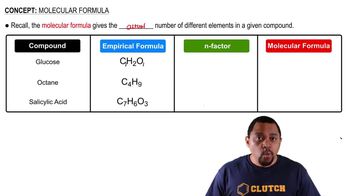Write the chemical formula for each substance mentioned in the following word descriptions (use the front inside cover to find the symbols for the elements you do not know). (b) On treatment with hydrofluoric acid, silicon dioxide forms silicon tetrafluoride and water. (use the front inside cover to find the symbols for the elements you do not know). (c) Sulfur dioxide reacts with water to form sulfurous acid. (use the front inside cover to find the symbols for the elements you do not know). (d) The substance phosphorus trihydride, commonly called phosphine, is a toxic gas. (e) Perchloric acid reacts with cadmium to form cadmium(II) perchlorate.
Ch.2 - Atoms, Molecules, and Ions

Brown15th EditionChemistry: The Central ScienceISBN: 9780137542970Not the one you use?Change textbook
Chapter 2, Problem 81d
d. What is the empirical formula for octane?
 Verified step by step guidance
Verified step by step guidance1
Identify the molecular formula of octane, which is C_8H_{18}.
Determine the greatest common divisor (GCD) of the subscripts in the molecular formula. For C_8H_{18}, the GCD is 2.
Divide each subscript in the molecular formula by the GCD to simplify the ratio. For C_8H_{18}, divide 8 and 18 by 2.
Write the simplified formula using the new subscripts obtained from the division. This gives the empirical formula.
The empirical formula represents the simplest whole-number ratio of atoms in the compound.

Verified video answer for a similar problem:
This video solution was recommended by our tutors as helpful for the problem above.
Video duration:
1mWas this helpful?
Key Concepts
Here are the essential concepts you must grasp in order to answer the question correctly.
Empirical Formula
The empirical formula of a compound represents the simplest whole-number ratio of the elements present in that compound. It does not provide information about the actual number of atoms in a molecule but rather the relative proportions of each element. For example, the empirical formula for glucose (C6H12O6) is CH2O, indicating a 1:2:1 ratio of carbon, hydrogen, and oxygen.
Recommended video:
Guided course

Empirical vs Molecular Formula
Molecular Formula
The molecular formula of a compound indicates the actual number of atoms of each element in a molecule. It can be derived from the empirical formula by multiplying the subscripts by a whole number. For octane, the molecular formula is C8H18, which shows that there are 8 carbon atoms and 18 hydrogen atoms in each molecule, while the empirical formula would reflect the simplest ratio of these elements.
Recommended video:
Guided course

Determining Molecular Formulas
Octane Structure
Octane is a hydrocarbon with the chemical formula C8H18, belonging to the alkane family. It consists of a straight-chain structure or branched isomers, where carbon atoms are connected by single bonds. Understanding octane's structure is essential for determining its empirical formula, as it helps in identifying the ratio of carbon to hydrogen atoms in the compound.
Recommended video:
Guided course

Resonance Structures
Related Practice
Textbook Question
Textbook Question
Assume that you encounter the following sentences in your reading. What is the chemical formula for each substance mentioned? (c) Hydrogen cyanide is a very poisonous gas.
Textbook Question
a. What elements are contained in hydrocarbons?
Textbook Question
a. What functional group characterizes an alcohol?
Textbook Question
b. Write a structural formula for 1-pentanol.
Textbook Question
All the structures shown here have the molecular formula C8H18. Which structures are the same molecule? (Hint: One way to answer this question is to determine the chemical name for each structure.)
